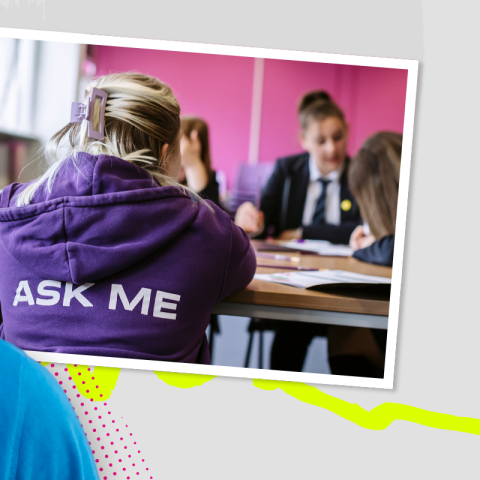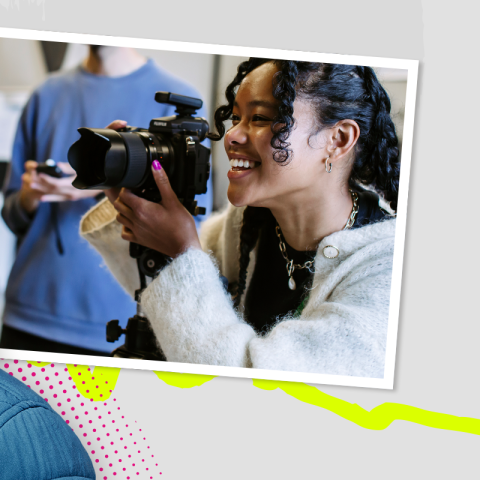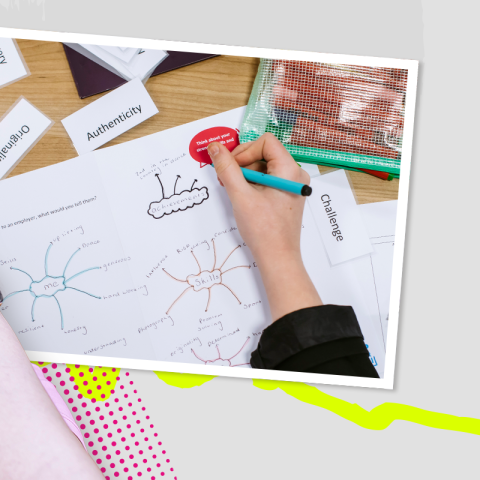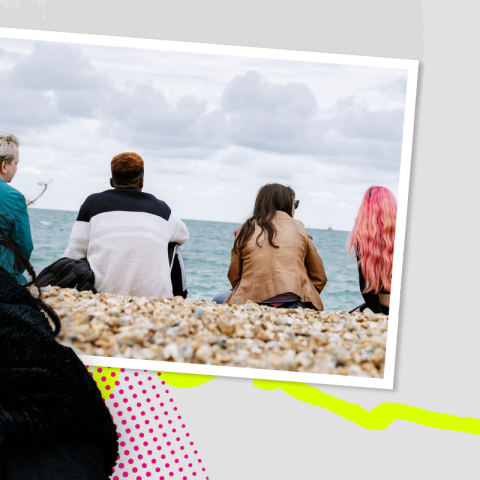

We all need a break sometimes
Top tips for managing stress and anxiety
Managing the workload of school, planning for the future, keeping up with your social life and taking part in any extracurricular activities is a lot to juggle.
It can all feel a little stressful at times, which is a completely natural feeling. But it's more important than ever to take time out to look after yourself. Here, you'll find useful tips to help you relieve stress and boost concentration.
Try mindfulness techniques
When we hear the word ‘mindfulness’, lots of us think of yoga or meditation, which may not be for you. But practising mindfulness doesn’t have to be a spiritual or deep and meaningful activity.
Simple techniques can really help in times of stress or anxiety and can be done as part of your daily activities or routine. They help build self-awareness by identifying our thoughts and emotions.
Write
- Writing things down will help you to get thoughts out of your head and on to paper
- Writing your thoughts down also makes you more aware of them and can then help you to process them, put them in to order or decide what to do next
- You could keep a journal, or simply scribble the words out on paper to organise later
Breathe
- Try holding your left hand out just in front of you, using your thumb and index finger to make an ‘L’. Using the index finger of your right hand, start at the top of your thumb
- As you breathe in, slide your finger along the edge of your ‘L’ shape
- When you reach the top, breathe out and slide your right index finger back down the ‘L’, do this until you feel calmer
Exercise
- Mindful exercise is usually exercise you do alone or in a quiet environment
- Focus on the individual movements you make, your feet on the floor, your arms swinging
- You could practice mindful walking, yoga or swimming. These activities are good because you can focus purely on the activity, rather than on competing with others or winning a match
Sleep
- Maintaining a sleep routine is really important for mental health and wellbeing, so take time to relax before you go to bed to help improve the quality of your sleep
- Be mindful of what time you go to sleep – try to sleep and wake up at the same time each day and get the recommended 7-8 hours per night
What is mindfulness and how can it help you?
Being Your Best
Discover the science behind mindfulness, how it can help you to perform at your best and some techniques to try at home.
Hi, everyone, and welcome to our being your best presentation.
My name's Kim and I work in the outreach team here at the University of Portsmouth.
And I'm going to be taking you through how we can use mindfulness techniques to be our best self.
So let's get started.
Some of the things we are going to cover in this video are kind of what is mindfulness and what is it not? Why is it so important? Techniques that you guys can try at home and then some useful resources as well.
You've probably heard people use the term mindfulness quite a lot.
It gets used quite a lot in schools and in other places as well.
But not everyone always knows exactly what it means.
So that's where I want us to start.
And you'll see on the screen we've got a definition from mindful.org.
And I think this definition really helps bring it back to basics that mindfulness is about awareness.
You'll see, it says about being present, being really aware of yourself and the situation.
And this can help us to react in a measured and thoughtful way.
Think, for example, it's a really frosty day outside.
You're just about to leave the house and your parents say to you, 'Oh be mindful of the ice'.
What does that mean? That means you would be aware of it.
You'd make sure you know where the ice is.
You would think about how that ice being there is going to impact on you and your situation.
That's what mindfulness is.
It's just awareness.
So I wanted us to cover what mindfulness is not as well.
Mindfulness is often confused with meditation.
Meditation is an excellent mindfulness technique, but you don't have to meditate to practice mindfulness.
If meditation isn't your thing, it doesn't mean you can't practice mindfulness.
And we'll come back to some techniques that you can use a little bit later on.
So why is mindfulness so important? Why does it seem to be the hot topic? Well, some stress in our lives is inevitable.
Generally, it's a short term experience, but knowing how to deal with that stress and to recognize it is really important to help us perform at our best.
And I want us to look at the science behind this.
When we look at how our body deals with stress, there are three really important parts of our brain involved in this process.
The first is a part of our brain called the thalamus.
The best way I've heard this described is as if it's the body smoke detector constantly scanning for opportunities or threats.
Now, if it picks up that things are all okay and things are good and we remain calm, our thoughts and our processing is remaining in our prefrontal cortex.
If, however, our brain senses danger, fear, panic, we shift over to our amygdala, which sends signals to our adrenal glands to release stress hormones.
And this is where we enter our fight, flight or freeze.
And you might have heard this phrase before.
So how does practicing mindfulness affect all of this? Well, having that awareness, taking the time out allows our brain to calm down and bring our thought process back from our amygdala into our prefrontal cortex so that we're not using our emergency fight, flight or freeze responses.
But instead we are calmly and rationally processing our thoughts.
You can see the cycle or process on the screen here.
Our thoughts have a huge impact on our feelings and ultimately our behaviours and therefore our performance.
And this is where we come back to performing at our best.
Mindfulness helps us to perform at our best.
And we've got a short clip here of LeBron James, one of the most famous basketball players and most successful players.
And there's just a short clip here of him in maybe quite a difficult game for him, just taking a breather, taking some time out.
Well first off, this is the last time out.
He has played the entire game.
He would have played the entire game in Game 6 if it wasn't a blowout.
We've talked about why mindfulness is so important.
What I want us to focus on now is some techniques that you can try at home in your own time.
Close your eyes and picture a gently flowing stream.
Imagine that there are leaves floating on the surface of that stream.
Now, any thought that pops into your mind, it might be a word, picture or anything else.
I want you to place it on a leaf and let it flow past you.
This exercise is not about you trying to stop or action any of those thoughts.
It's purely about being aware of them.
Writing things down is a really good way of getting your thoughts out of your head and onto paper, which will immediately make you feel better.
There are different techniques you can try, such as journaling or mind maps.
Exercise is really important for our well-being.
It helps us to relieve stress and to work through different emotions.
The importance here for mindful exercise, though, is that it's done alone or in a quiet environment.
It's really difficult to have that mindful awareness that we talked about earlier if you're in a noisy environment or focusing on playing sport as a team.
Meditation, as I mentioned earlier, is a really popular mindfulness technique.
That's because meditation is all about training your brain to be more self aware and focused.
Meditation doesn't have to be done cross-legged on a yoga mat, though.
You can sit in a chair, you can stand.
It's just about being comfortable so that you're not distracted.
And finally breathing techniques.
There are lots of these out there, but I want us to try this one together now.
Try holding your left hand out in front of you.
Making an L-shape with your thumb and index finger.
Using your index finger on your right hand.
Start at the tip of your thumb.
And as you breathe in, slide your right finger along the edge of your L-shape.
When you reach the tip of your index finger.
You're going to pause and then breathe out, sliding your finger back down the L to the tip of your thumb.
You can do this until you feel calm.
But let's try just one cycle now.
So breathe in, and breathe out.
Good.
The final thing I wanted to show you was just some resources that you can use to find out more information about mindfulness or different techniques.
Don't forget to download our PDF tipsheet for more details on the techniques we went through in the presentation.
On the screen here you've also got four different websites and four different apps that you can try.
These are by no means all that's out there.
They're just a few that we found have some really positive information.
Don't forget, you can also follow us on Instagram to hear more from us as an outreach team.
Please remember that mindfulness techniques are not one size fits all.
You'll need to try different things and see what works for you.
Different things might work on different days.
Just give it a go and enjoy.




